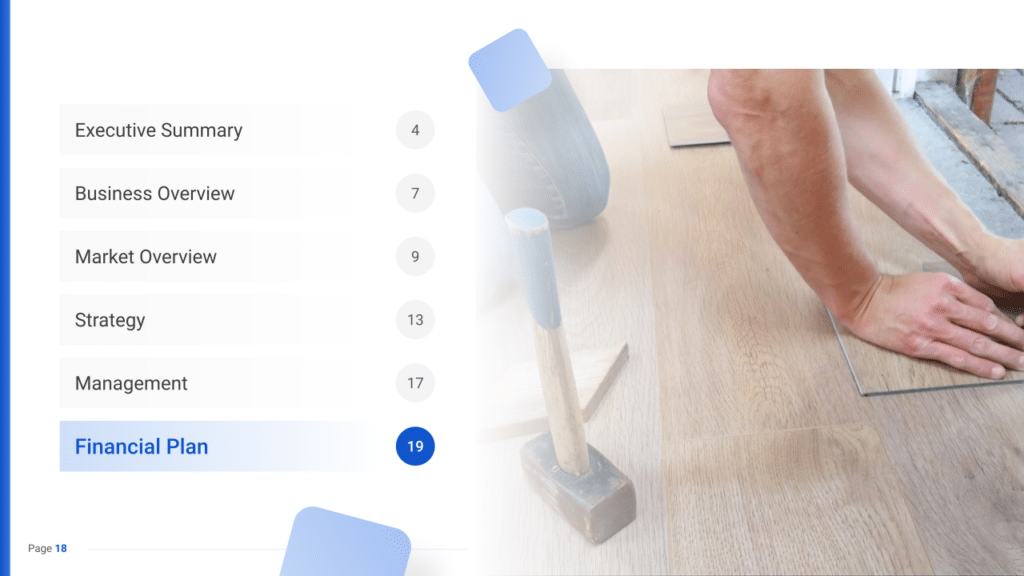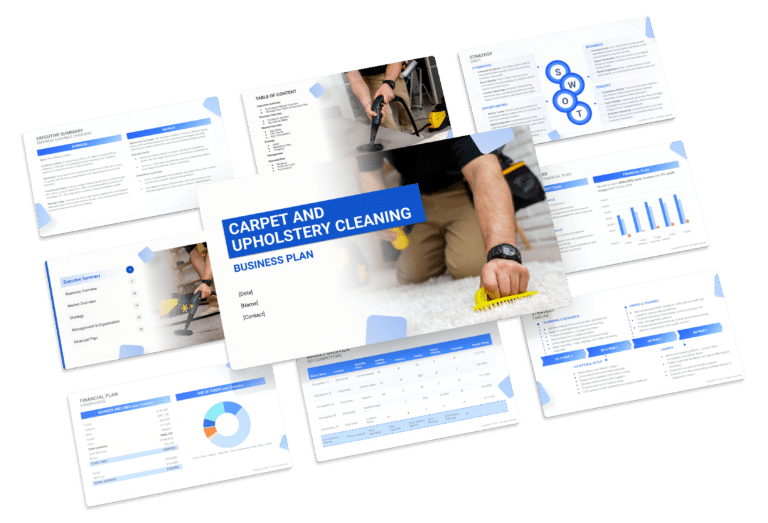Flooring Business Plan Template & PDF Example

Creating a comprehensive business plan is crucial for launching and running a successful flooring business. This plan serves as your roadmap, detailing your vision, operational strategies, and financial plan. It helps establish your flooring business’s identity, navigate the competitive market, and secure funding for growth.
This article not only breaks down the critical components of a flooring business plan, but also provides an example of a business plan to help you craft your own.
Whether you’re an experienced entrepreneur or new to the service industry, this guide, complete with a business plan example, lays the groundwork for turning your flooring business concept into reality. Let’s dive in!
The Plan
Our flooring business plan is structured to cover all essential aspects needed for a comprehensive strategy. It outlines the company’s operations, marketing strategy, market environment, competitors, management team, and financial forecast.
- Executive Summary: Offers an overview of your business’s concept, market analysis, management team, and financial strategy.
- Business Overview: Provides detailed information on what your business offers and its operational model:
- Services & Rates: Lists the services provided by your business, including specific offerings and pricing structure.
- Market Overview: Examines the industry landscape, identifying competitors and how your business stands out:
- Key Stats: Shares industry size, growth trends, and relevant statistics.
- Key Trends: Highlights recent trends affecting the industry.
- Key Competitors: Analyzes main competitors in the area and how your business differentiates itself from them.
- Strategy: Outlines how your business intends to achieve growth and attract clients:
- SWOT: Strengths, weaknesses, opportunities, and threats analysis.
- Marketing Plan: Strategies for attracting and retaining customers.
- Timeline: Key milestones and objectives from start-up through the first year of operation.
- Management: Provides information on the management team and their roles, emphasizing their qualifications and experience.
- Financial Plan: Projects the business’s 5-year financial performance, including revenue, profit and loss, fundraising needs, cash flow statement, and balance sheet.

Executive Summary
The Executive Summary presents an overview of your flooring business plan, succinctly describing your business and the range of flooring solutions you offer. This section should articulate your market positioning, detailing the variety of flooring services provided, including installation, maintenance, and repair of various flooring types such as hardwood, laminate, vinyl, and tile. It should also highlight the business’s location, size, and an outline of daily operations.
This segment will further delve into how your flooring business will establish itself within the local market. It should assess the competitive landscape, including the number of direct competitors in the vicinity, identifying who they are, and emphasizing your business’s unique selling propositions that set it apart from these competitors.
Moreover, the summary should encompass information about the management and co-founding team, elucidating their roles and the value they bring to the business’s success.
Additionally, a synopsis of your financial forecasts, including revenue and profit projections over the next five years, should be included to offer a comprehensive view of your flooring business’s financial strategy.
Flooring Business Plan Executive Summary Example
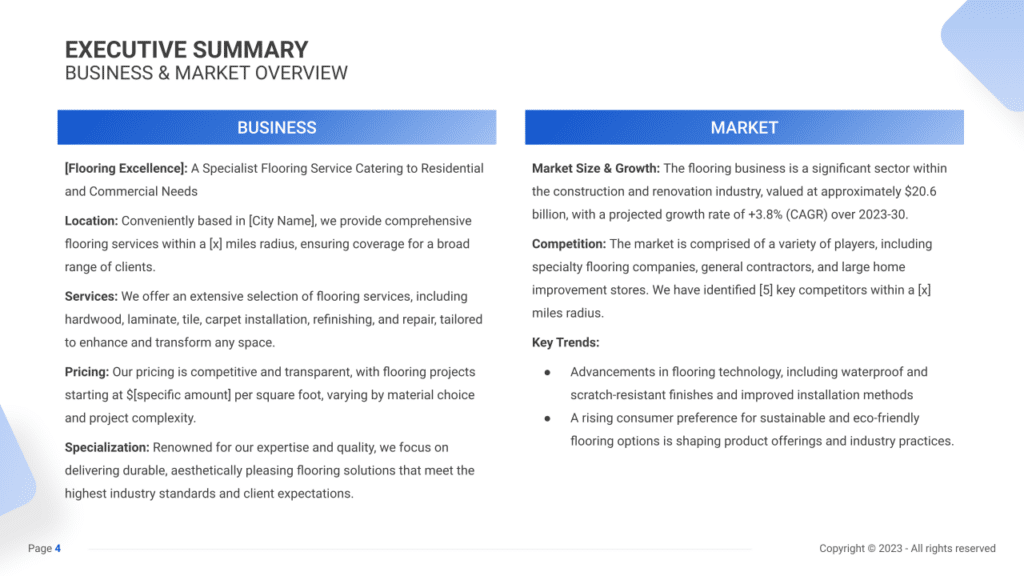
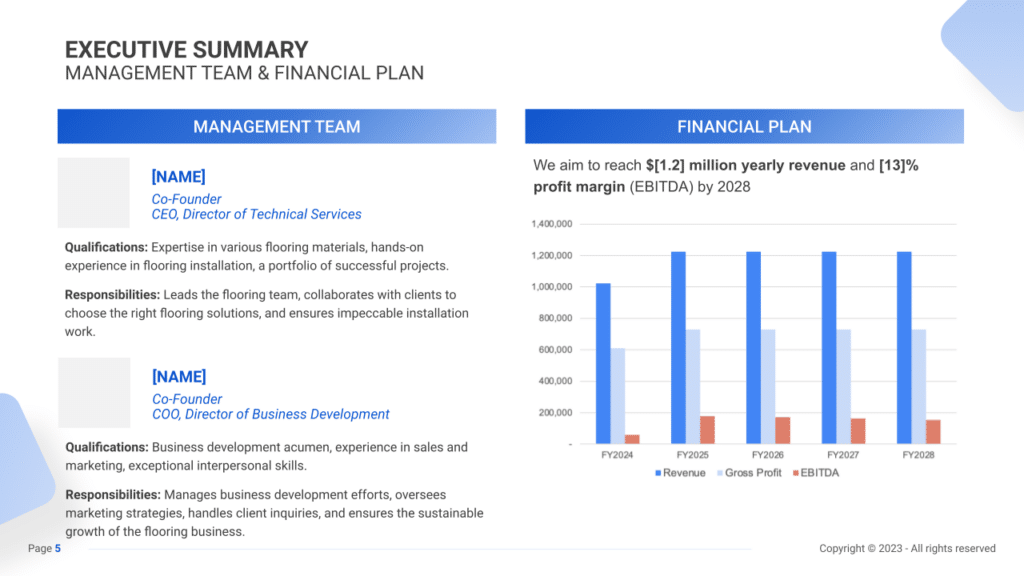
Business Overview
In presenting a compelling executive summary for a flooring business, it is essential to provide fundamental details such as the business name, location, and an outline of the services offered. Highlighting the Unique Selling Proposition (USP) is critical, emphasizing what makes the flooring business stand out among competitors.
Example:
“Flooring Excellence” is a prominent flooring service situated in [City Name], offering an extensive array of flooring solutions for both residential and commercial needs. Our specialization covers a broad spectrum, from hardwood, laminate, and tile to carpet installation, refinishing, and repair. Our unique edge lies in delivering top-notch, durable flooring solutions, accentuated by the latest technological advancements in the industry, such as waterproof and scratch-resistant finishes, meeting the growing demand for sustainability and eco-friendliness.
Market Overview
An impactful flooring business summary should delve into the market’s size, growth trends, and industry dynamics, substantiated with relevant data and emerging trends. Equally significant is identifying key competitors and positioning the flooring business amidst the competitive landscape.
Example:
The flooring business is a significant sector within the construction and renovation industry, valued at approximately $20.6 billion and showcasing a projected growth rate of +3.8% (CAGR) over 2023–2030. Flooring Excellence stands among various players, including specialty flooring companies, general contractors, and large home improvement stores. Our competitive edge thrives on technological advancements, offering eco-friendly flooring options, and delivering superior-quality installations, setting us apart in a dynamic market.
Management Team
The expertise and qualifications of the management team are pivotal in building credibility. This section underscores the critical roles of team members, assuring stakeholders of the flooring business’s capability to deliver exceptional services.
Example:
Flooring Excellence is steered by a proficient management team with extensive expertise in various flooring materials and installation techniques. Their collaborative approach in assisting clients to choose suitable flooring solutions and ensuring impeccable installation work underscores our commitment to deliver unmatched services, further cementing our position as industry leaders.
Financial Plan
The financial plan is a strategic blueprint outlining the flooring business’s fiscal goals and projections, encompassing revenue targets, profit margins, and strategies for financial growth and sustainability.
Example:
Flooring Excellence is geared toward achieving significant financial milestones, aiming for $1.2 million in yearly revenue and a 13% operating profit margin (EBITDA) by 2028. This strategic trajectory is propelled by our commitment to technological advancements and eco-friendly practices, combined with competitive pricing and unwavering dedication to customer satisfaction. These strategies, led by our proficient team, are poised to drive consistent growth and profitability, consolidating Flooring Excellence as a reputable name in the flooring industry.
Business Overview
Services & Rates
List the services you offer, like putting in new floors, fixing them, and keeping them looking good. Describe how you set your prices, making sure they’re fair and show the quality of your work. Mention any special deals or discounts that help keep customers coming back.
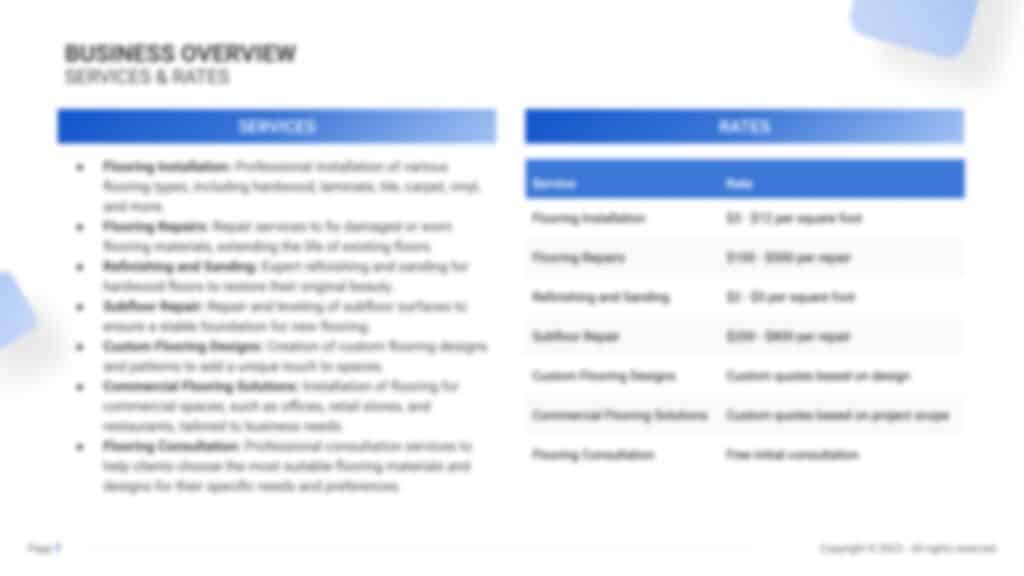
Market Overview
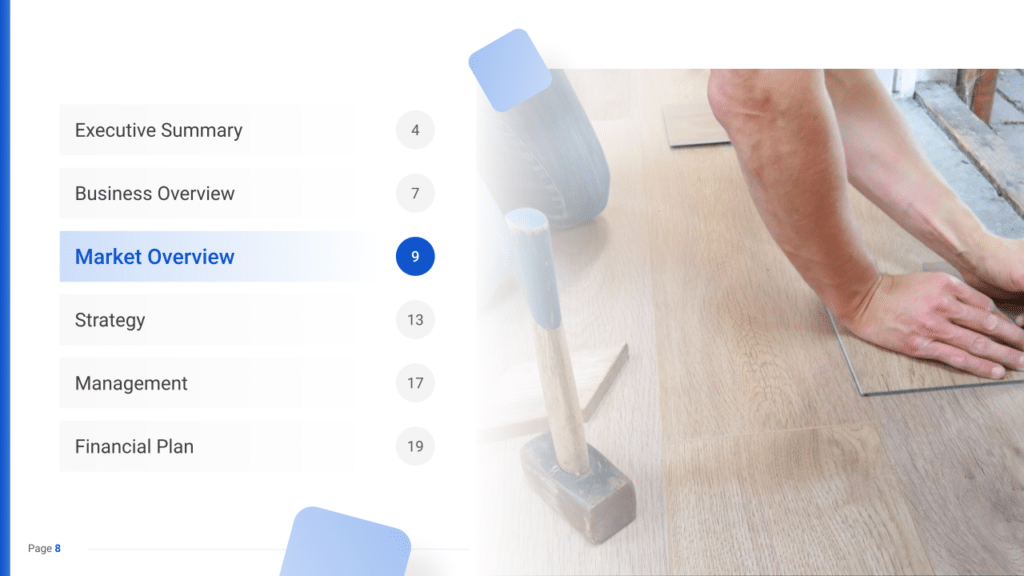
Industry Size & Growth
In the Market Overview for your flooring business plan, begin with an analysis of the flooring industry’s size and its potential for growth. This assessment is vital for grasping the market’s breadth and pinpointing opportunities for expansion.
Key Market Trends
Next, delve into current market trends, such as the growing consumer interest in durable and eco-friendly flooring options, the appeal of luxury vinyl tile for its versatility, and the increasing preference for personalized and innovative flooring solutions. Highlight the demand for flooring that not only meets aesthetic preferences but also functional requirements, like easy maintenance and durability, along with a shift towards sustainable and green flooring materials.
Competitive Landscape
A competitive analysis is not just a tool for gauging the position of your flooring business in the market and its key competitors; it’s also a fundamental component of your business plan. This analysis helps in identifying your flooring business’s unique selling points, essential for differentiating your business in a competitive market.
In addition, competitive analysis is integral in laying a solid foundation for your business plan. By examining various operational aspects of your competitors, you gain valuable information that ensures your business plan is robust, informed, and tailored to succeed in the current market environment.
Identifying Your Competitors in the Flooring Industry
Begin by mapping out the landscape of local flooring businesses, including retailers, installation services, and manufacturers. For instance, if your flooring business specializes in sustainable flooring solutions, your direct competitors may include other eco-friendly flooring stores and contractors, as well as larger home improvement retailers offering similar options. Furthermore, consider indirect competitors such as interior design firms or furniture stores that also offer flooring solutions.
Leverage online tools like Google Maps and business directories to create a comprehensive list of competitors. Websites like Houzz and HomeAdvisor can provide additional insights through customer reviews and ratings, shedding light on the strengths and weaknesses of competitors. For instance, if a competitor, “EcoFloor Innovations,” receives high praise for its wide range of eco-friendly materials and professional installation services, this information can be a key consideration in your analysis.
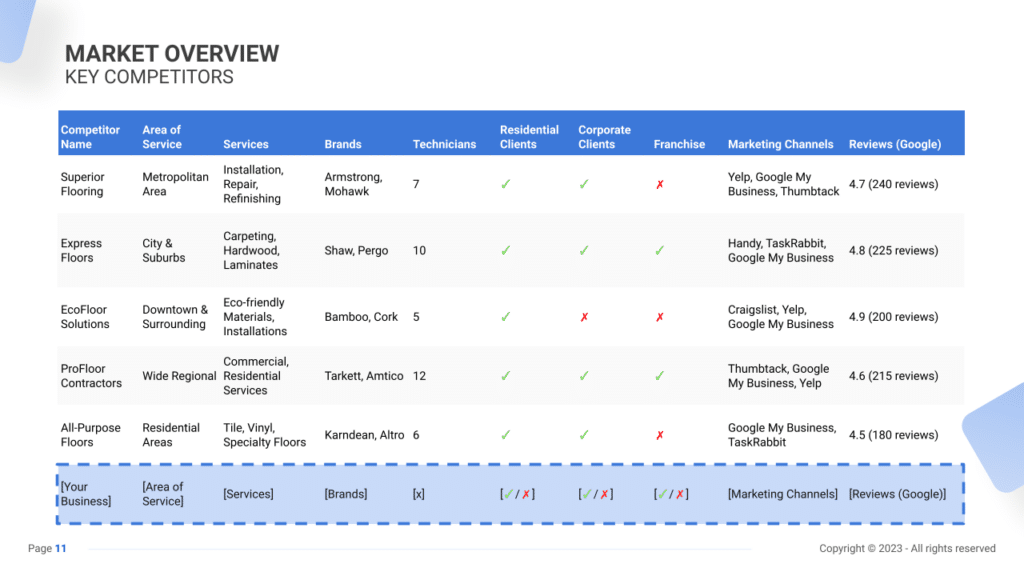
Flooring Business Competitors’ Strategies
Analyzing the strategies of competitors encompasses various facets:
- Product Offerings: Evaluate the range of flooring materials and designs offered by competitors. If “Luxury Floors & Tiles” is gaining traction with its upscale marble and hardwood collections, it indicates a market segment inclined towards premium materials.
- Installation Techniques: Consider the installation methods and expertise. A company like “Precision Flooring Solutions” specializing in intricate custom designs might appeal to a different clientele than a business focused on quick and budget-friendly installations.
- Pricing Structure: Compare your pricing strategy with that of competitors. Are your services competitively priced in alignment with mid-range market players, or do you position yourself as a high-end service like “Elite Floorcrafters”?
- Marketing Approaches: Assess competitors’ marketing channels and approaches. Do they invest heavily in digital marketing, or do they thrive on local networking and referrals within the construction industry?
- Customer Experience: Evaluate the customer experience provided by competitors. For instance, a competitor like “Seamless Flooring Services” might excel in customer satisfaction due to their prompt response and efficient problem-solving.
- Operational Efficiency: Look for technological advancements or innovative practices used by competitors. For example, “Smart Floor Solutions” might leverage augmented reality tools for clients to visualize flooring options in their space.
What’s Your Flooring Business’s Value Proposition?
Define your flooring business’s unique value proposition. Perhaps your business specializes in customizable, environmentally friendly flooring solutions or offers exclusive designs sourced internationally.
Identify gaps in the market by gathering customer feedback and observing industry trends. For instance, if there’s a rising demand for sustainable flooring but limited availability from competitors, this represents an opportunity for your business to fill that niche.
Consider location-specific factors. A flooring business in a commercial district might emphasize durable, low-maintenance options, while a business in residential areas could focus on aesthetics and comfort to cater to homeowners’ preferences.
Strategy
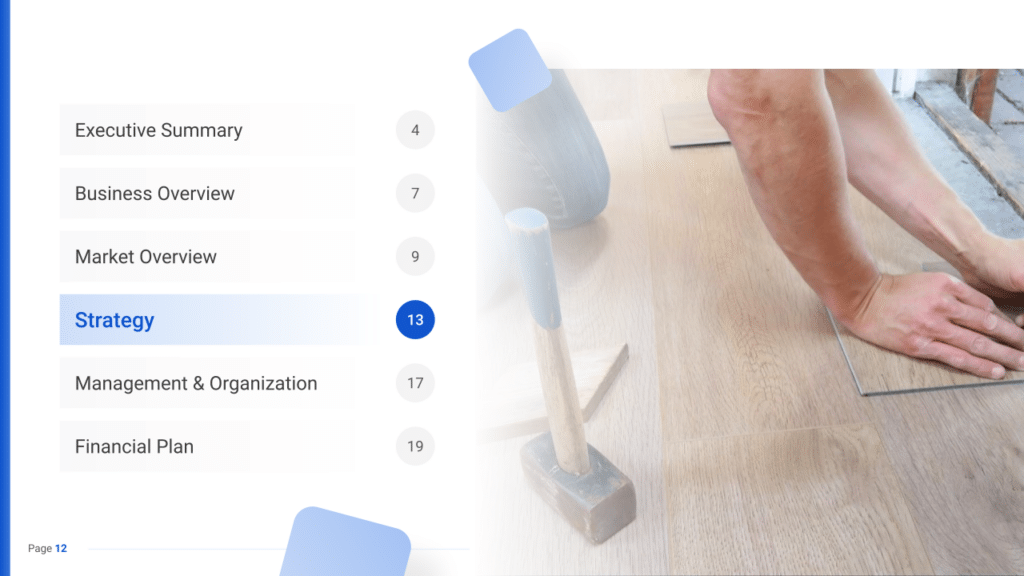
SWOT
Start with a SWOT analysis for the flooring business, identifying Strengths (like a wide range of high-quality flooring options and expert installation services), Weaknesses (such as limited market presence or intense competition), Opportunities (for instance, the growing demand for eco-friendly and sustainable flooring), and Threats (like market fluctuations that may impact consumer spending on home improvements).
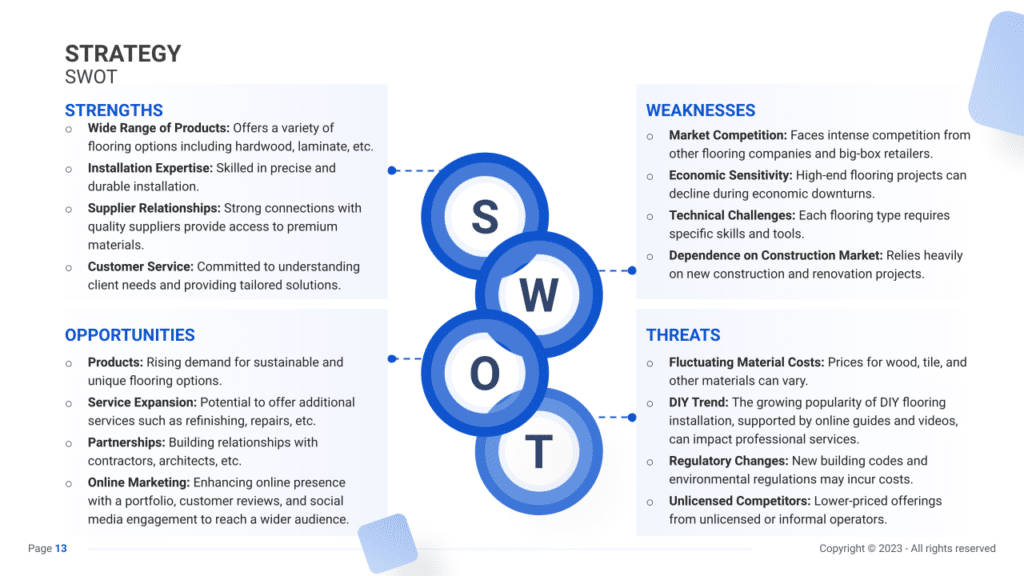
Marketing Plan
Then, craft a marketing strategy that focuses on how to draw in and keep customers. This could include targeted advertising campaigns, special offers, a strong online presence with engaging content, and participation in local community events.
Marketing Channels
Utilizing diverse marketing channels is crucial to reaching potential customers and enhancing brand visibility in the flooring industry.
Digital Marketing
- Website and SEO: Build a professional website showcasing your flooring portfolio, customer testimonials, and informative blog posts on flooring trends, maintenance tips, and design inspiration. Optimize it for local SEO to rank higher in search results.
- Social Media: Leverage platforms like Instagram, Houzz, and Pinterest to showcase stunning flooring installations, before-and-after transformations, and customer testimonials. Engage with your audience through educational content, polls, and Q&A sessions.
- Email Marketing: Develop an email list by offering valuable content like flooring guides, exclusive discounts, and updates on new products or services.
Local Advertising
- Print Advertising: Place ads in local home decor magazines, newspapers, and community newsletters. Distribute well-designed flyers in home improvement stores, real estate agencies, and community centers.
- Networking and Community Engagement: Attend home expos, renovation trade shows, or local community events to showcase your flooring expertise. Collaborate with interior designers, realtors, and contractors for referrals and joint ventures.
Promotional Activities
Enticing offers and promotions can attract potential customers and foster brand loyalty in the flooring market.
Special Deals
- Seasonal Promotions: Besides seasonal promotions, experiment with loyalty-exclusive offers or surprise flash sales, generating excitement and incentivizing repeat purchases.
- Referral Programs: Implement targeted referral programs by providing exclusive benefits not just to the referrer but also to the referred customers, encouraging a network effect and expanding your customer base.
- Educational Content and Workshops: Expand the scope of educational content by introducing comprehensive guides, tutorials, or interactive tools on your website, offering practical solutions to common flooring concerns or DIY installation tips. Host engaging workshops or webinars in collaboration with industry experts, positioning your flooring business as a reliable source of expertise and guidance in the industry.
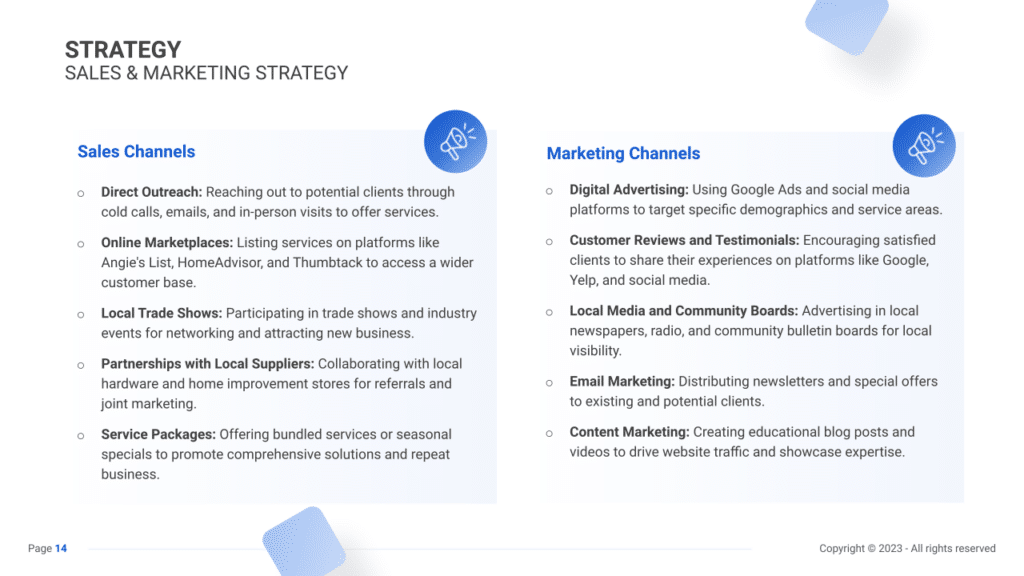
Sales Channels
Effectively utilizing sales channels ensures seamless customer experiences and maximizes revenue opportunities for your flooring business.
In-Person Consultations and Upselling
- Personalized Consultations: Offer free in-home consultations to assess flooring needs and provide tailored recommendations, fostering trust and personalized service.
- Upselling Opportunities: Maximize upselling opportunities by presenting value-added services or bundled offerings during consultations and providing a holistic flooring solution aligned with customer preferences.
E-Commerce and Online Sales
- Online Catalog and Sales Platform: Innovate the online shopping experience by refining the user interface and navigation of your e-commerce platform, ensuring seamless browsing and comparison of flooring materials.
- Virtual Visualization Tools: Implement virtual room visualizers or augmented reality apps to allow customers to visualize different flooring options in their spaces before making a purchase decision.
Installation and After-Sales Service
- Professional Installation Services: Further emphasize the expertise of your installation team through detailed behind-the-scenes content, customer testimonials, or informative guides showcasing the meticulousness and professionalism of every installation.
- Customer Relationship Management: Implement systems to maintain communication with customers post-installation, seek feedback, and offer maintenance tips to ensure long-term satisfaction.
Membership and Loyalty Programs
- Membership Options: Introduce membership programs offering exclusive benefits such as priority scheduling, discounts on future purchases, or extended warranties.
- Loyalty Rewards: Establish a loyalty program where customers earn points or rewards for repeat purchases, referrals, or engaging with your brand on social media.
Strategy Timeline
Lastly, lay out a detailed timeline that marks key milestones for the flooring business’s launch, marketing initiatives, customer base development, and goals for growth, ensuring the business progresses with clear goals and a sense of direction.

Management
The Management section focuses on the flooring business’s management and their direct roles in daily operations and strategic direction. This part is crucial for understanding who is responsible for making key decisions and driving the flooring business towards its financial and operational goals.
For your flooring business plan, list the core team members, their specific responsibilities, and how their expertise supports the business.
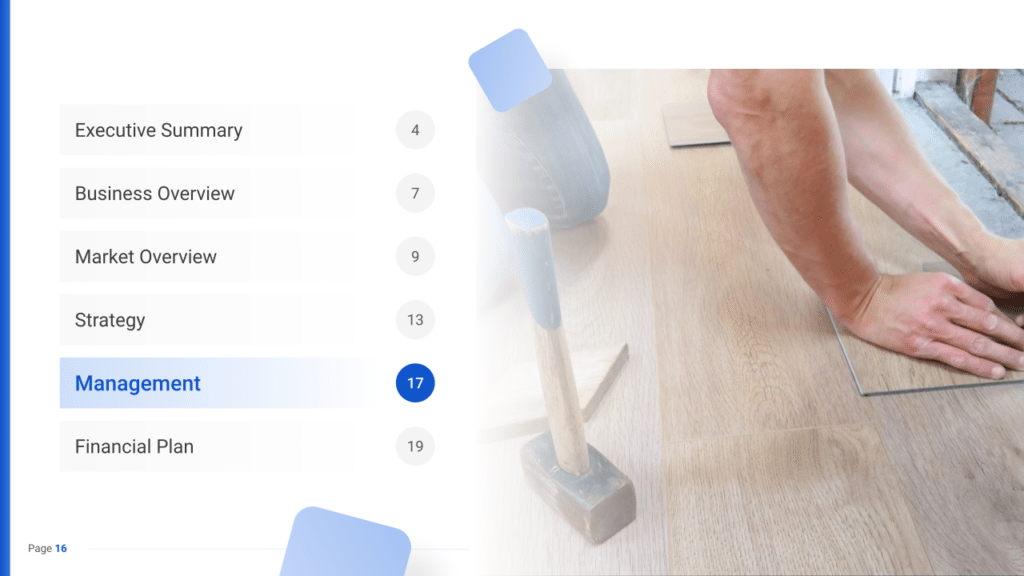

Financial Plan
The Financial Plan section is a comprehensive analysis of your financial projections for revenue, expenses, and profitability. It lays out your flooring business’s approach to securing funding, managing cash flow, and achieving breakeven.
This section typically includes detailed forecasts for the first 5 years of operation, highlighting expected revenue, operating costs and capital expenditures.
For your flooring business plan, provide a snapshot of your financial statement (profit and loss, balance sheet, cash flow statement), as well as your key assumptions (e.g. number of customers and prices, expenses, etc.).
Make sure to cover here
_ Profit and Loss
_ Cash Flow Statement
_ Balance Sheet
_ Use of Funds
